For most companies, website localization isn’t just a technical decision. You should maintain brand consistency, speed up time-to-market, and scale across markets – without breaking your front end or your localization manager’s spirit. The right software helps you do all three. The wrong one creates bottlenecks you’ll feel in every campaign.
We’ve tested and compared the best website localization platforms so you can cut through the noise and pick the one that works for your site, workflow, and goals.
Let’s get into it.
Website localization: two ways to do it
When you need to translate your website, you have two options.
Relevant reading: Website Localization Guide for 2025
Option 1. Outsource everything to a localization agency
You hand off website localization to a service provider who handles translation, project management, QA, and delivery.
Pros? It’s a set-it-and-forget-it approach.
Cons? It’s often expensive, slow to update, and gives you limited control over the process, translation accuracy, and quality.
This approach can backfire fast if your content is highly technical, brand-sensitive, or changes weekly. So, it’s not ideal for startups, creative teams, and companies that need full control.
Relevant reading: 13 Best Localization Service Providers
Option 2. Use website localization software
You can adopt a website localization platform for more flexibility and control without draining your budget or bandwidth. The right platform integrates with your CMS, helps you maintain brand consistency, and optimizes translated content for SEO – all from one place.
Before we dive into the best website localization tools on the market, let’s break down the two main models first.
Picking the right website localization software for your team
When you’re searching for a website localization tool, you’re probably after more than just translation. You want a solution to automate workflows, handle content review, and seamlessly integrate with your existing website without breaking everything. That’s what a translation management system (TMS) is built for: one tool to manage your entire localization process.
However, a proxy-based localization solution might be a better fit if you want quick results and are willing to give up some control.
Proxy tools sit between your website and the user, swapping out text on the fly with translated content. Your original website and code remain untouched, but users see a fully translated version in their language.
Proxy solutions run on third-party infrastructure, so you don’t need dev resources to get started. They also include built-in multilingual SEO and can automatically generate hreflang tags and localize URLs for search engines. On the downside, you don’t fully own the infrastructure and may become dependent on the provider’s uptime and support. Proxy solutions also struggle with complex infrastructures and JavaScript-heavy or dynamic websites (like those built with React or Vue).
TMS vs. Proxy: Which one fits your website?
There’s no one-size-fits-all answer. Here’s a quick breakdown of how the two approaches compare 👇
Note: We’ll mark each tool in the list as “TMS” or “Proxy” to help you navigate.
| Use case | Proxy | TMS |
|---|---|---|
| Speed and simplicity | ✅ | ❌ |
| Ownership and control | ❌ | ✅ |
| SEO support | ⚠️ Risk of poor indexing or cloaking | ✅ |
| Data privacy and security | ⚠️ Can expose content via proxy layer | ✅ |
| Works with complex, dynamic websites and workflows | ❌ | ✅ |
| Brand consistency and tone control | ⚠️ Limited editorial oversight | ✅ |
| Content versioning and rollback | ❌ | ✅ |
| Built-in reporting and analytics | ❌ | ✅ |
| Scales with growing teams and markets | ⚠️ Limited in the long run | ✅ |
Our selection criteria
We picked tools that work for teams of all sizes, from startups to enterprises. For this, we focused on:
- Scalability. Can support multiple markets and handle complex workflows but still usable by smaller teams without months of setup and onboarding.
- Flexibility. Covers different localization models, including low-code setups, fully managed proxy solutions, and dev-friendly TMS to accommodate different IT teams. All tools on the list integrate with common CMS and dev tools.
- Affordable to start, but robust enough to grow into.
- Support for international SEO and compliance features.
The best website localization software at a glance
| Type | Integration level | MT | CAT tools | Best fit for | Main pros and cons | |
|---|---|---|---|---|---|---|
| Centus | TMS | Medium (Git, APIs, CMS, Figma) | ✅ | ✅ | Mid-size teams looking for affordable TMS with workflow automation | 👍 Flexible, scalable, automation-friendly 👎 Sparse documentation |
| Smartling | TMS | High (APIs, CMS, code) | ✅ | ✅ | Enterprises with complex localization and compliance needs | 👍 Enterprise-grade features and automation 👎 Expensive, steep learning curve |
| Weglot | Proxy (with limited TMS tools) | Low (proxy layer) | ⚠️ Basic MT only | ⚠️ Basic | SMBs, startups, marketing teams needing instant multilingual sites | 👍 No-code, SEO friendly, easiest to deploy 👎 Limited control, price scales fast |
| Crowdin | TMS | High (Git, API, Figma) | ✅ | ⚠️ Limited | Tech-savvy teams needing Git-based or agile workflows and integrations | 👍 Git-native, great collaboration 👎 Less friendly for non-technical users |
| Transifex | TMS | High (Git, API) | ✅ | ⚠️ Limited | Agile SaaS/product teams managing UI/content at scale | 👍 Developer-friendly, flexible API 👎 Fewer built-in QA tools |
| MotionPoint | Proxy | Low (fully or partly managed) | ❌ Handled externally | ❌ Not user-accessible | Large enterprises with limited IT resources | 👍 No-code, fully (or partly) managed, SEO optimized 👎 Expensive, limited customization |
Relevant reading: What Are CAT Tools?
Centus. Balanced TMS for growing teams
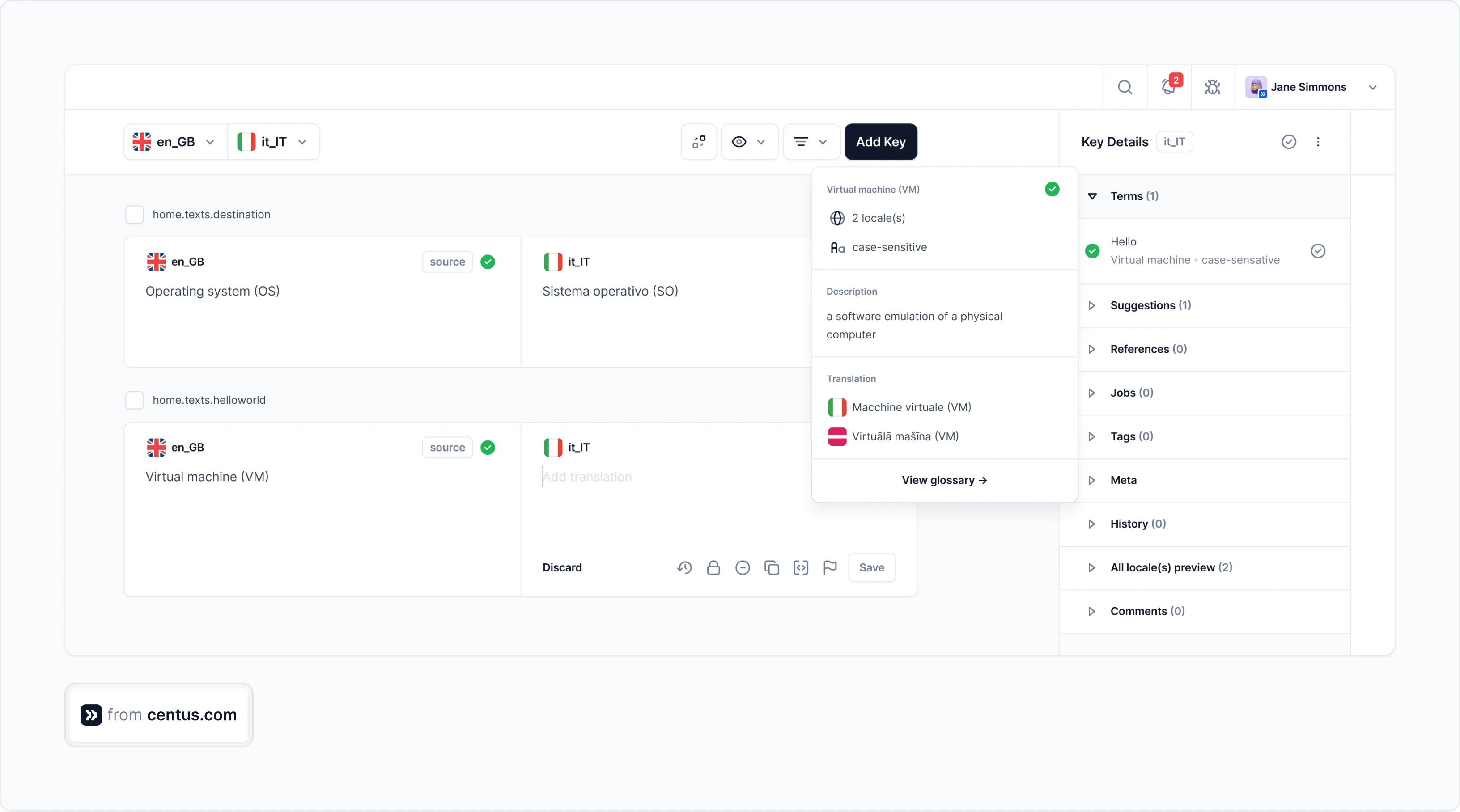
🚀 Quick overview
- Modern TMS with a built-in CAT tool. Balances ease of use and technical features.
- From $145/month
- Free trial available
- G2 score: 5/5
🎯 Best for
Agile SMBs and growing teams that want full control, strong automation, and integrations without the enterprise price tag or complex setup.
CAT & QA features
✅ Translation memory, glossary, and term base
✅ Built-in QA checks
✅ Native CAT editor
✅ Machine translation (MT) integration
Why we picked Centus
👉 Disclaimer: Centus is first in the list for a reason – and no, not because you’re reading this on the Centus blog. Centus fills a clear gap between expensive, complex, enterprise-grade TMSs and lightweight proxy tools.
Centus offers enterprise-level capabilities, including automation, a built-in CAT tool, glossary, machine translation, translation memory and terminology management, QA checks, collaborative workloads, and developer integrations – all at a price accessible for smaller, non-enterprise teams.
Whether you need a TMS for full process control and transparency or just want a simple tool that can scale as you grow, Centus delivers on both.
Relevant reading: Compare Centus with other localization platforms
Smartling. Enterprise TMS for complex workflows
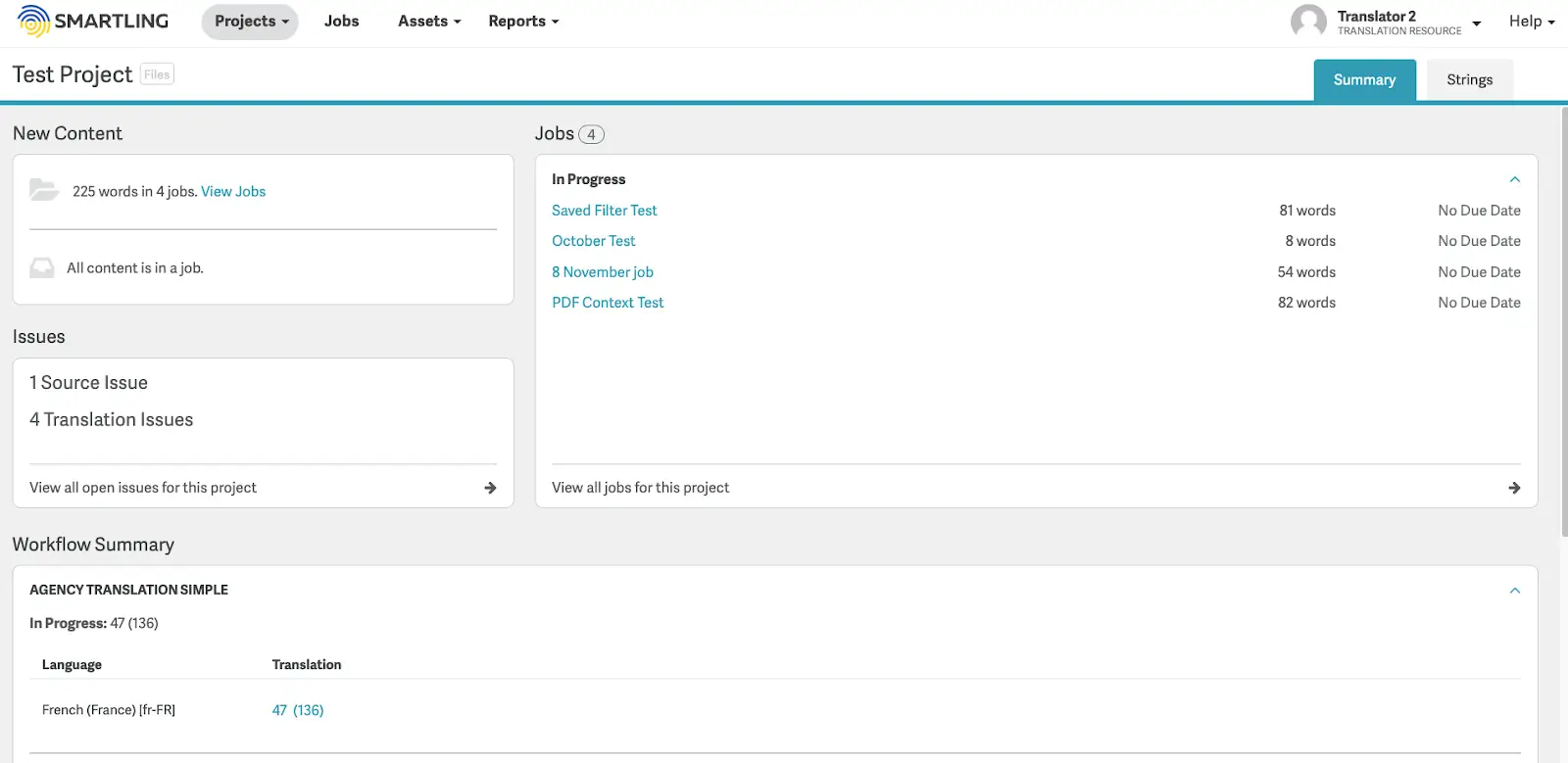
🚀 Quick overview
- Enterprise-grade TMS with built-in CAT tool, visual context, QA, translation memory, automation, and customizable review workflows.
- Custom pricing
- No free trial on the website
- G2 score: 4.4/5
🎯 Best for
Large organizations working with in-house and vendor linguists that need high-quality translation, automation, and full workflow control.
CAT & QA features
✅ Translation memory and term base
✅ In-browser CAT tool
✅ Built-in QA checks
✅ MT integration
Why we picked Smartling
Trusted by Shopify, Pinterest, and Reddit, Smartling is one of the most feature-rich website localization platforms on the market. It includes everything: built-in CAT tools, visual context editor, review layers, automated QA, and fully customizable workflows – even if your approval workflow is longer than your actual content.
The trade-off: higher cost and a learning curve that may slow down less experienced teams.
Weglot. No-code localization for eCommerce
![Weglot no-code website translation settings][https://centus-localization-bucket-production.s3.eu-central-1.amazonaws.com/blog/post/media/73119rDe7g26PSd9BwNutJV9107296RqbF2PF4MI.webp]
🚀 Quick overview
- No-code, proxy-based website translation with basic TMS features and strong SEO support.
- From $17/month
- Free trial available
- G2 score: 4.7/5
🎯 Best for
Marketing, eCommerce, and B2C teams that need fast, simple multilingual websites without dev involvement.
CAT & QA features
✅ Translation memory and glossary support
⚠️ Human review available via the editor, but no full CAT tool
⚠️ Limited QA functionality
⚠️ Basic MT only
Why we picked Weglot
Weglot is a standout in website localization used by IBM, Amazon Studios, and HBO. This no-code solution automatically detects content and handles SEO out of the box. It works with all major CMS like Webflow, WordPress, Shopify, and Wix, allowing you to translate your website into over 100 languages in mere minutes.
Even though Weglot supports AI translation and allows you to add human reviews for better accuracy, you still get limited control over tone and consistency. Pricing also scales quickly as your content and languages grow.
Crowdin. Dev-centric TMS for agile product teams
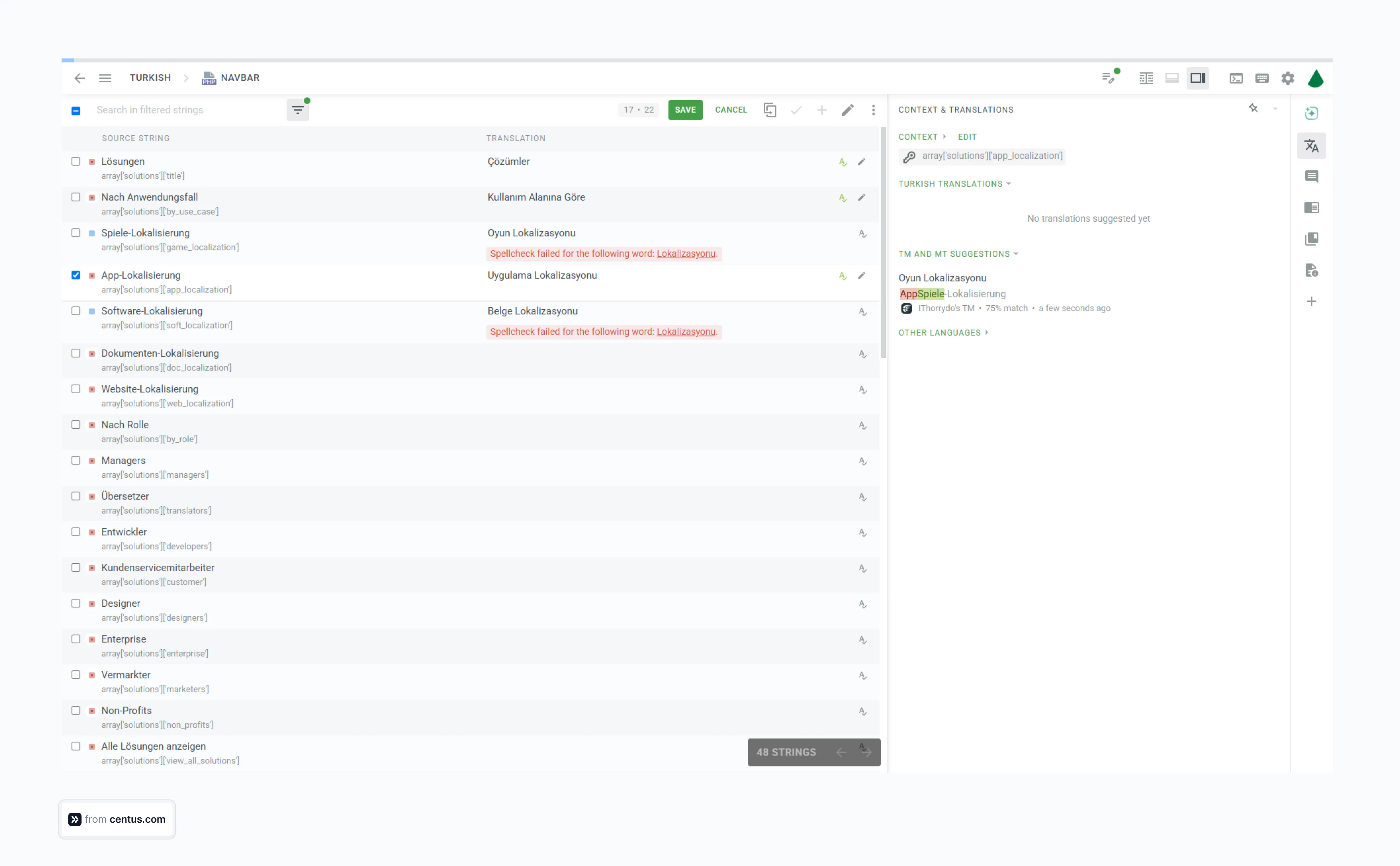
🚀 Quick overview
- Developer-centered TMS with strong Git-based workflows and open-source support.
- From $50/month
- Free trial available
- G2 score: 4.4/5
🎯 Best for
Agile product teams, startups, SaaS companies, and open-source communities with dev-heavy localization needs.
CAT & QA features
✅ Translation memory, glossary, and term base
⚠️ Built-in CAT tool with an editor (not as advanced as Smartling)
⚠️ Basic QA checks (placeholders, tags)
✅ MT integration
Why we picked Crowdin
Crowdin is built for engineering-first teams, supporting Git, CLI, REST API, webhooks, 600+ integrations, and 100+ file formats. No surprise tech giants like GitHub, GitLab, Discord, Microsoft, and Citrix trust it. Crowdin also includes in-context editing, supports custom localization workflows, and integrates with machine translation.
Keep in mind: this is a dev-first tool. If your team isn’t technical, expect a learning curve.
Transifex. API-first TMS for SaaS companies
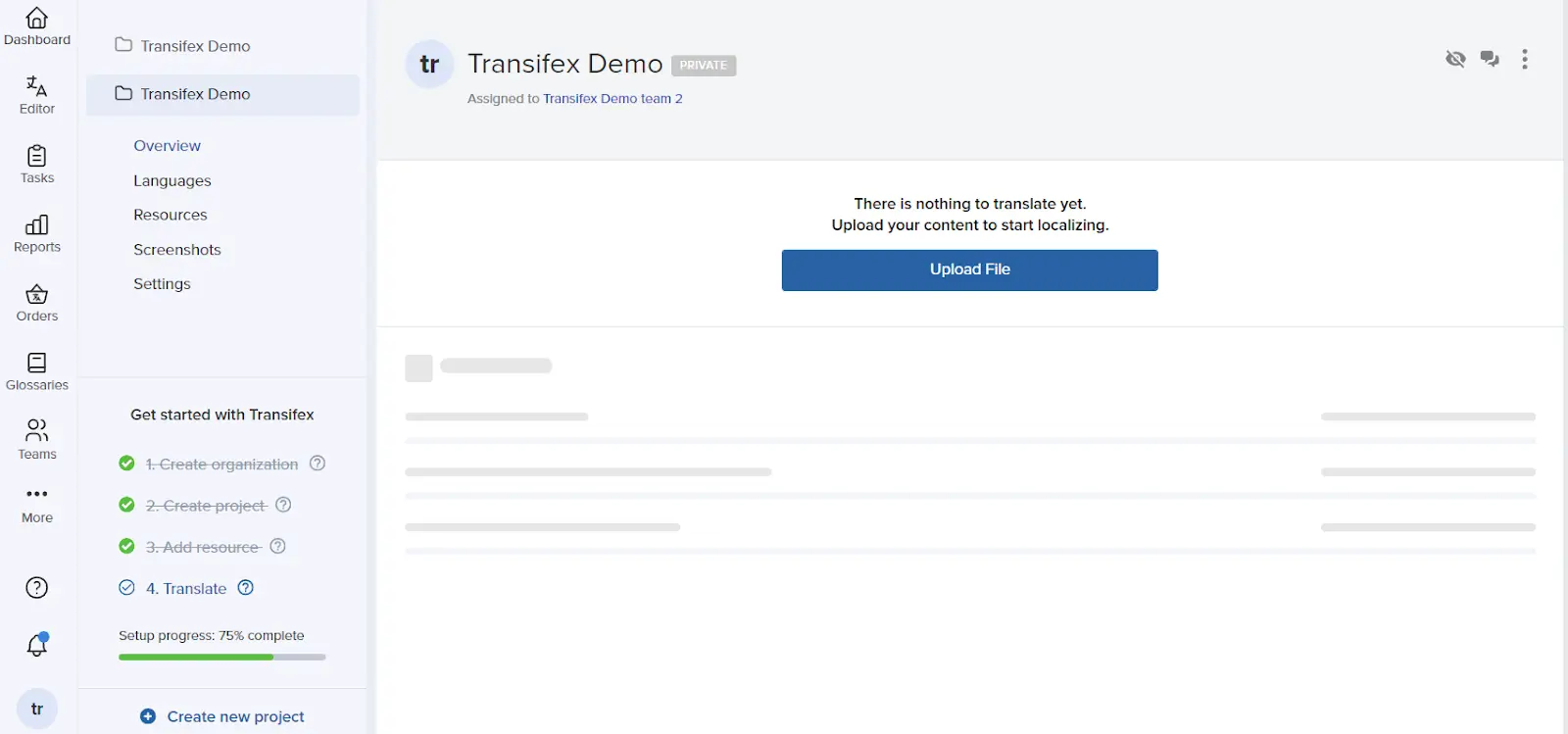
🚀 Quick overview
- TMS designed for agile and developer-led teams, with more basic CAT features compared to enterprise tools like Smartling.
- From $145/month
- Free trial available
- G2 score: 4.3/5
🎯 Best for
Agile teams with frequent content updates, including SaaS, content-heavy websites, startups, or scale-ups with engineers in the loop.
CAT & QA features
✅ Translation memory, glossary, and term base
⚠️ Basic web-based editor (less feature-rich than Smartling or Crowdin)
⚠️ Basic QA checks (tag mismatch, placeholder)
✅ MT integration
Why we picked Transifex
Transifex is another dev-friendly TMS on our list but with a gentler learning curve than Crowdin. It can be used by mixed technical and non-technical teams where marketing, product, and engineering all need to collaborate.
Trusted by Atlassian, HubSpot, Quora, and Rakuten Viber, Transifex offers advanced structured content management, marketing localization features, and compatibility with a broad range of formats.
MotionPoint. Fully managed proxy for enterprises
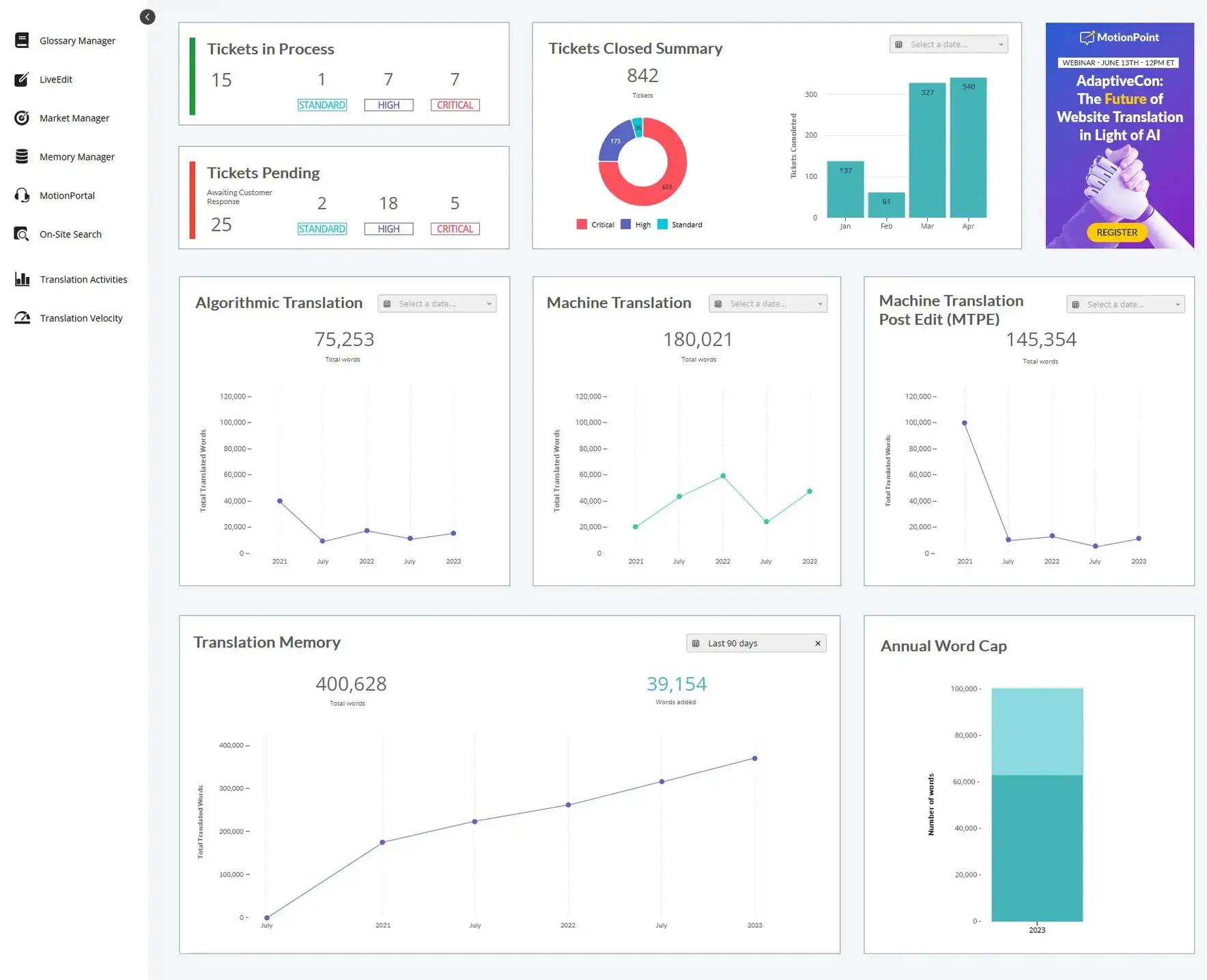
🚀 Quick overview
- Full-service, proxy-based solution that handles everything — translation, deployment, SEO, and infrastructure — with minimal lift from your team.
- Custom pricing
- No free trial on the website
- G2 score: 4.6/5
🎯 Best for
Enterprise companies with limited localization resources or strict compliance needs looking for a hands-off, fully managed solution with minimal internal effort.
CAT & QA features
✅ Pattern-based translation memory, glossary, and term support (via Brand Voice AI)
❌ No user-accessible CAT tool
⚠️ QA handled by MotionPoint’s internal teams
✅ MT integration
Why we picked MotionPoint
MotionPoint brings over 25 years of experience in website localization and offers both fully and partly managed website localization solutions, depending on how involved you want to be. Although it’s traditionally hands-off, it can also integrate with your CMS via APIs.
Large brands like WebMD, PapaJohns, and Norwegian Cruise Lines choose MotionPoint when they need a no-fuss, fully managed approach. Its proxy-based system even handles dynamic JavaScript – a common weakness for most proxy tools.
On the downside, MotionPoint lacks transparency and control. There is no in-context editing, CAT access, and dev integrations.
Parting thoughts
Hopefully, our guide saved you a few hours of tab-switching, pricing-page stalking, and “free trial” regrets. You’ve now seen the pros and cons of today’s best website localization platforms – and know what’s actually worth your team’s time.
Looking for more than website localization software? Check out our guide on Best Localization Platforms and Tools Ranked for 2025.
And if you want a localization platform that doesn’t require a Slack war between marketing and dev… try Centus. Your localization manager will thank you.
Happy translating — and may your hreflang tags never fail.
Get the week's best content!
By subscribing, you are agreeing to have your personal information managed in accordance with the terms of Centus Privacy Policy ->
Keep learning
12 min. read
Best Game Localization Services: 2025 Rating

14 min. read
Reviewing 10 Best Online Translators: Free & Professional
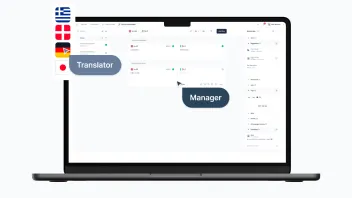
6 min. read